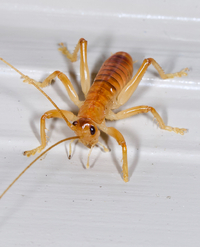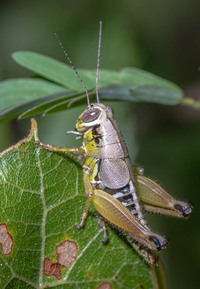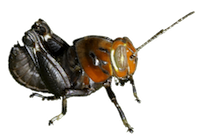Submitting a Record
Before submitting a record, read Terms of Use/Privacy Statement. Our intention is to make the information gathered in the website as widely available as we can make it. We therefore follow the guidelines established for Fair Use of published materials, although we also make provisions for anyone who would like to have stronger copyright recognition for the photographs they submit.
To send us a record, click on Submit a Public Record on the menu located on the left side of the Home Page. Only records of reliably identified species serve the interests of this project to document the distribution, natural history, and conservation status of the Orthoptera of North Carolina. To make the record most useful for these purposes, we therefore require that certain information be filled in, as indicated in red text on the form.
Species Name
The submitter needs to take the initial step in trying to identify the species the record represents. This helps the submitter learn more about the identification process (and its problems). It also helps us process the records more quickly. For help in establishing this preliminary identification, click on the Identification Guide located on the menu at the top of the Home Page. Although this initial identification does not have to be completely accurate – we will vet the photograph or other evidence as part of the acceptance process – the more precise it is, the faster we can process the submission. Conversely, records that require more time and effort on the part of our reviewers are likely to be delayed in acceptance, sometimes (we regret to say) indefinitely.
Identity of the Observer
The name of the person must be included and an email address where the submitter can be reached; we do not accept any records from anonymous or otherwise unverifiable sources. Only the observer’s name will show up in the species accounts, not the email address, which will be used only to notify the submitter concerning the status of their record (see Vetting Process below); it will not be shared with anyone outside of the website group without permission from the submitter.
Date and Location of the Record
For the record to be useful to us, we require information on the date and location of the observation. The date for records of adults will be used to compile the flight charts, with one record per site per location per night used for that purpose. Locations for all records – adults or immatures – will be used to fill in the distribution maps displayed for the species. Although only the counties will show up in the public display on the website, we need more accurate locational information to help identify sites of particular conservation interest as well as to help identity the habitat and landscape context where the record was made. The exact location of the observation can – preferably – be entered through use of the mapping tool included on the form or through direct entry of coordinates (in decimal degrees) obtained from a GPS unit. We would also like the name of the site to be included, if identifiable (e.g., a town or nature preserve), along with any descriptive subunit (e.g., neighborhood name, street address or location along a road, or topographic location – e.g., floodplain or ridgetop)..
Number of Individuals; Methods of Observation; Life Stages
The abundance of a species is usually one of the main factors in determining its conservation status – the less abundant the species, the higher its presumed risk and hence the higher its priority for protection. However, the number of Orthoptera seen at a particular time and place varies widely, depending on weather conditions, phase of the moon, timing of the life cycle of the particular species, and the methods used for the observations. We are particularly interested in the effects due to the type of observation method, e.g., bait vs. lights, blacklights vs. mercury-vapor lights, searching for larvae vs. adults. While not required – we will enter a single individual as a default if no estimates of numbers are recorded – either exact counts of the individuals seen at a given time or estimates (for observations above 5 individuals) can help us determine the detectability of a given species using a particular method. This is information that we summarize in the Species Accounts under Methods of Observation. Along with the flight charts, distribution maps, and habitat information, we hope this will be useful in planning how to look for particular species.
Where several methods were used, or where both immatures and adults were recorded at the same time and place, enter records separately for each category, each with an estimate of the number of individuals observed.
Habitat
Gathering information on the habitats used by moth species is one of the most important goals of this project. We use this information to help determine the ecological and conservation needs of the species. We also regard as one of our main missions to acquaint the public about the diversity of habitats we have in North Carolina and how each one plays a role in sustaining our native biodiversity.
The habitats listed on the entry form are simplified, our hope being that most people will be able to identify them; a description of each habitat type can be seen by clicking on the name of the habitat. We also invite the submitters to provide additional information about the habitats, including the presence of host plants used by the moth species, in the Comments section. For experienced observers, we recommend using the more detailed vegetation categories described in the Natural Communities of North Carolina (Schafale and Weakley, 1990; Schafale, 2012).
More than one habitat type can be selected. Since Orthoptera observed at lights or bait are often drawn in from distance of 100 yards or more, we ask that all habitat types within that radius be recorded.
Comments
The Comments section is optional but can be used to record information about habitat, host plants used by larvae, predator-prey interactions, or other behavioral or ecological features of interest.
Adding the Photograph
Photographs (including copies of sound spectrographs) provide the basis for documenting a record and must be included as part of all submissions (records from specimens obtained from surveys conducted by expert Orthopterists are recorded through a separate process). As noted in the Species Accounts, however, some species cannot be identified based on photographs alone; records entered for species flagged as requiring specimens as the basis for a record (see Adult ID in the Identification panel) will not be accepted. Where a specimen of such species has, in fact, been collected, contact the Orthoptera Website Group at Orthoptera_of_NC_Website@outlook.com for further information.
Attach your photograph by browsing to the file where it is stored on your computer, opening the file by clicking the name or image, and then clicking on the Open button shown at the bottom of the form window. Usually only one photograph should be entered per species per site per date, but up to three shots can be entered, showing a given individual from different angles or several individuals displaying a range of variation in pattern or other features.
Completion of the Form
Following the Security Check and acceptance of the Terms of Use at the bottom of the form, clicking the Submit button will enter the completed record.
Vetting Process
Once a record has been submitted, the proposed identification is reviewed by our team of experts to confirm its accuracy. This vetting is based partly on the long experience of our group members with moth identification but also on the availability of reliable keys and other diagnostic information in the scientific literature. For Orthoptera, such information is available for nearly all taxonomic groups and species (although subject to change depending on the discovery of new information); the references we use for this purpose are cited in the Species Accounts.
Even where modern keys or other good taxonomic information exist, not all species have diagnostic traits that are visible in photographs; many need to be collected in order to identify them to species, making use of features that can only be seen under a microscope or that require dissection in order to be revealed. The information needed for vetting a given species will normally be included in the Identification Comments field in the Species Accounts. However, we are still in the process of compiling this information and it will take us some while to complete the process for all species occurring in the state. In the meantime, we have made an effort to categorize the evidence required for vetting. For adult Orthoptera, we use the following levels listed for Adult ID Requirements in the Species Accounts:
1. Sight records are allowed. Species in this category are all widespread and widely recognized by the public, e.g., Luna Moths. In most cases, however, a short description – e.g., “large, green moth with long tails on the hindwings” – should be included in the Comments field on the entry form.
2. Photographs are required for identification, but must be of good enough quality and taken of specimens in good condition in order to be accepted. For this category, photos of a species in its normal resting position provide sufficient information for vetting.
3. Photographs showing particular views are required – e.g., side views of the head, showing the palps – or additional information must be supplied, such as body length or habitat information. This category also includes species where one sex or morphological variant may be determined using photographs but others cannot. Normally, these information requirements will be explained in the Identification Comments field.
4. Specimens are required for identification. This category includes species whose diagnostic traits can only be seen under high magnification or that require dissection or that can only be determined through DNA analysis.
Currently, we are filling in the Adult ID Requirements for all Orthoptera confirmed as occurring in the state. Where no designations are specified, we are handling entries on a case-by-case basis
Records that have been vetted to the species level will be added to the Species Accounts. In the case of photos submitted for vetting level 4 species – requiring a specimen – we may place them in Genus Accounts, provided they can be determined to the genus level; the same is true for species in level 3, if insufficient information is provided to determine the individual species. In all cases where a record has been entered into the website, it will be listed under New Records as well as the Species or Genus Accounts, but no other notification will be sent to the submitter. Where the record is not accepted or where additional information is required, a message may be sent to the submitter via email.
Currently, we are able to process the records within a two week period (usually less).


 on the left, or to the next species in the checklist order by clicking on the Eotettix
on the left, or to the next species in the checklist order by clicking on the Eotettix  on the right. You can also get to additional species by entering text in either of the Search Common or Search Scientific boxes; click on the full species name; then click on the blue Find tab. A third way to get to another species (within the same Family) is to click the down arrow under the scientific name, where the box shows other members in the Family; click on the species of interest.
on the right. You can also get to additional species by entering text in either of the Search Common or Search Scientific boxes; click on the full species name; then click on the blue Find tab. A third way to get to another species (within the same Family) is to click the down arrow under the scientific name, where the box shows other members in the Family; click on the species of interest.